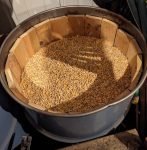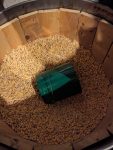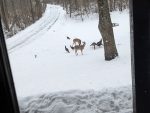“Some deer came to the squirrel feeder today,” Kari announced at supper one evening. Kari and I both love deer. Kari loves deer because she thinks that they are pretty. I love deer because I think that they are tasty. As a result, our priorities don’t always coincide. But we do both agree that we like having deer around on the property. It isn’t that I have ever actually shot deer on our property. I just want them nearby in case I get hungry.
The squirrel feeder had not always been a squirrel feeder. It was originally a platform that I had built to hold a salt block for the deer. But when the deer consistently ignored the salt, the platform eventually became a place where we set out stale bread and other treats for the squirrels that flourished in the woods near our home. Harsh weather conditions in January and February had made it difficult for the deer to find sufficient food. Now they were getting desperate enough to compete with the squirrels for scraps of stale bread.
“One of the deer was crippled,” Kari continued. “She couldn’t walk on one of her front legs. And she was pregnant too!”
I suddenly knew that our family had acquired a new dependent.
Kari bought a 40-pound bag of shelled corn for the deer. Between the deer, squirrels, turkeys, and other wild inhabitants of the wetlands surrounding our home, the corn did not last long. Kari began making plans for purchasing more.
At that moment, I had an inspiration. I said, “I purchased some shelled corn back in 2016. It has been stored in a steel drum in the pole barn ever since. It is due to be rotated. Let’s use that corn instead.”
Background
Before 2016, I don’t think anyone would have described me as a “Prepper.” I owned firearms and I lived in a log home in the woods. That was about as far as any imagined resemblance between me and preppers went. I had just lived life hoping that American society would flow along without any major disruptions for the foreseeable future. For many years that hope was enough to lull me into a sense of complacency. Then, in 2016, two events took place that changed my perspective.
The first event took place in a thrift store near my home. As I was browsing in the used book section, I ran across a novel entitled Patriots by someone named James Wesley, Rawles. It looked like it had an interesting plot, so I bought the book. Later, when I began to read, I was enthralled. I could easily imagine a societal disruption taking place similar to the one described in the novel. I had previously come to the conclusion that deficit spending by the United States government was unsustainable. The novel presented a highly plausible scenario of what might take place when that spending pattern collapsed.
The second event that took place in 2016 was the presidential election of that year. The level of invective in the campaign was unlike anything I had ever experienced before. The words of Jesus as quoted by Abraham Lincoln echoed in my mind: “A house divided against itself cannot stand.” Regardless of who won the election, I thought that there could be some level of civil unrest. Even if that unrest did not directly spill over into my community, it might disrupt supply chains. It would be wise to be prepared.
So on May 18, 2016, I sat down and wrote the words “Survival Plan” across the top of a page in my project journal. I then wrote, “Before election day…” and began my first crude list of preps.
I did not have much money to work with, so the first item on my list was “Cheap source of calories.” I also listed a cheap source of protein, ammo for my various firearms, a 9mm handgun with ammo, a rifle with four high-capacity magazines and ammo, cooking oil, a grain mill, a water filter, a rain barrel, and archery broadheads.
The list wasn’t much, but it was something. They say a journey of 1,000 miles begins with a single step. My journey had begun.
As I considered a cheap source of calories, one of the cheapest that I could come up with was shelled corn. I can’t remember what it cost at the time, but even today I can buy 250 pounds of shelled corn for less than $50. With more than 400 calories per pound, that 250 pounds of shelled corn could provide more than 1,000 calories per day each to Kari and to me for 50 days. That would be a significant help in helping us navigate any supply chain issues that might arise.
But the question then arose, “How am I going to securely store 250 pounds of shelled corn? If I keep it in bags, rodents will almost certainly get into it. Even if pests don’t get into it, it may be spoiled by moisture.” My solution was a wood-lined steel drum.
A Wood-Lined Steel Drum
A wood lining would prevent condensation from collecting on the inside of the drum and spoiling the corn. The steel would seal the drum against both rodents and humidity. Placing dry ice inside the lid of the drum before sealing it would fill the drum with carbon dioxide, killing any insects. The theory sounded good. I decided to give it a try.
Locating the Drum
In December, a search of the then newly-launched Facebook Marketplace revealed that a candy factory near our home was selling food-safe, 55-gallon steel drums with lids for $8 each. The drums had been used to ship non-stick pan coating that the factory used to keep the candy from sticking to their molds. I hooked up my trailer, drove to the factory, and bought two of the drums.
Lining the Drum
 I cut a plywood circle approximately 22 inches in diameter and dropped it into the bottom of the drum. Then I cut 18 lengths of untreated pine one-by-fours each 31 inches long. I stood the one-by-fours side by side around the inside of the drum. Next, I filled the drum with shelled corn that I had purchased at a local farm supply store. I estimated that five 50-pound bags would fill the drum. I was wrong. There was some extra space left, so I bought a sixth bag and added most of its contents to the drum as well. The drum ultimately held about 280 pounds of shelled corn.
I cut a plywood circle approximately 22 inches in diameter and dropped it into the bottom of the drum. Then I cut 18 lengths of untreated pine one-by-fours each 31 inches long. I stood the one-by-fours side by side around the inside of the drum. Next, I filled the drum with shelled corn that I had purchased at a local farm supply store. I estimated that five 50-pound bags would fill the drum. I was wrong. There was some extra space left, so I bought a sixth bag and added most of its contents to the drum as well. The drum ultimately held about 280 pounds of shelled corn.
I then made a three-piece wooden lid to fit on top of the ends of the one-by-fours. The lid consisted of two semicircles made out of plywood with a third piece of plywood that fit over the crack between the two semicircles. I selected a three-piece rather than a one-piece lid for two reasons. The first was that a three-piece lid was easier to insert and remove than a solid plywood circle. The second was that I did not have a piece of plywood the proper size to make a solid plywood circle, but I did have some pieces the proper sizes to make the three-piece lid described above.
Sealing the Drum
I had planned to put dry ice in the top of the drum before sealing it to kill any insects that might have found their way into the drum. We ended up having a snap of unusually cold weather, with sub-zero temperatures. I had heard of killing insects in stored grain by putting containers in a deep freeze. I believed that the cold snap would serve the same function, so I placed the lid on the drum, put the ring around the lid, and tightened the ring.
In the years since, I have often found insects living and moving in the woodshed even during sub-zero temperatures. As a result, I am no longer confident that exposure to cold is an effective method of killing insects in stored grain. On the other hand, there was no sign of any insect activity in the drum when I opened it more than eight years after I had sealed it.
Storing the Drum
I placed some wooden planks over cinder blocks along the wall of the pole barn, and put the drum on the planks. This was to prevent the drum from corroding due to direct contact with the cement floor. The drum then sat on those blocks and planks for the next eight years. Old tarps, scraps of carpet and carpet padding, and other materials gradually got stacked on the drum over the course of the years. It was buried and largely forgotten until Kari expressed the need for corn to feed the deer.
Opening the Drum
I first removed the tarps and other materials that we stacked on top of the drum. I did not remember that we had so many old tarps, old targets, a rusted Tonka toy bulldozer, plastic drop cloths, carpet scraps, carpet padding, and other assorted items.
I loosened the nut securing the ring in place with a ratchet wrench, and removed the ring and lid.
I removed the top wooden lid. The corn had settled a couple of inches, but otherwise it appeared intact.

 I began scooping the corn into empty kitty litter buckets using an old plastic coffee can. The coffee can was too small, so I switched to a gallon-sized tin pail. Each kitty litter bucket took about six tin pail loads to fill it and weighed about 35 pounds when filled. I ended up filling just over eight of the kitty litter buckets with corn. The corn was well preserved, and quickly proved very popular with the local wildlife. As I write these words in February, I can look out of the kitchen window at a flock of turkeys that is enjoying the corn. The turkeys chased off the squirrels. The deer just joined them.
I began scooping the corn into empty kitty litter buckets using an old plastic coffee can. The coffee can was too small, so I switched to a gallon-sized tin pail. Each kitty litter bucket took about six tin pail loads to fill it and weighed about 35 pounds when filled. I ended up filling just over eight of the kitty litter buckets with corn. The corn was well preserved, and quickly proved very popular with the local wildlife. As I write these words in February, I can look out of the kitchen window at a flock of turkeys that is enjoying the corn. The turkeys chased off the squirrels. The deer just joined them.
Conclusions
The wood-lined steel drum seemed highly effective at storing corn. There was no absolutely no sign of any damage from rodents, insects, moisture or other causes. I will likely use the method again for storing other grains in the future.
Disclaimer
I did not receive any financial or other inducement to mention any vendor, product, or service in this article.
Read the full article here

